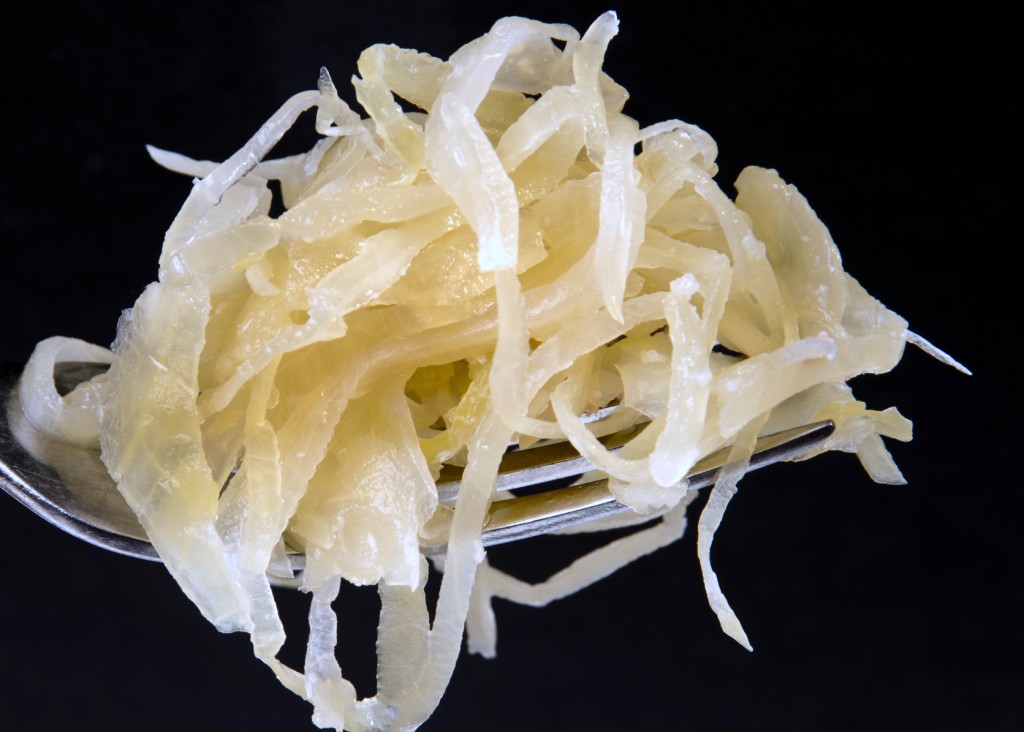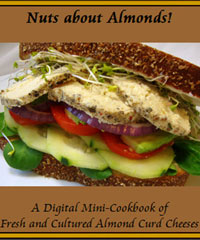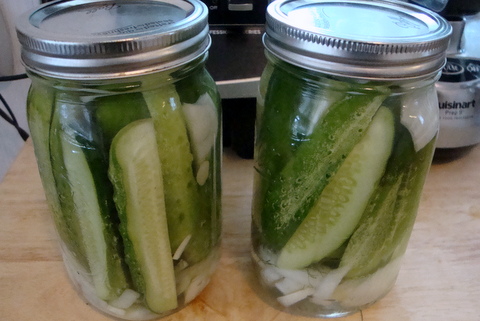
These easy-to-make pickles are fresh, crisp, tangy and nicely seasoned. The amount of brine is sufficient for preparing 2 quarts of pickles.
Ingredients:
• cucumbers, any variety, but pickling cucumbers are best
• 1 large onion, thinly sliced
• 3 cups filtered water
• ½ cup champagne vinegar or white vinegar
• 3 T sea salt or kosher salt
• 1 T organic sugar
• 2 T minced garlic (6 cloves)
• 2 T fresh chopped dill
• 1 tsp whole coriander seeds (optional)
• 1 tsp whole peppercorns or ½ tsp red pepper flakes (optional)
• 2 bay leaves
Technique:
In a bowl or large measuring cup, dissolve the salt and sugar in the vinegar and water to create the brine. Add the onion, garlic, bay leaves, dill and optional coriander seeds and pepper to a large container with a lid, or divide among 2 mason jars.
For smaller cucumbers, such as pickling cucumbers, leave unpeeled and slice in half or quarter lengthwise. For larger salad cucumbers which have tougher skins, use a vegetable peeler to cut strips of peel away, leaving some of the peel intact. This gives the cucumbers a nice variegated appearance; then cut into ¼ to ½-inch crosswise slices.
Stand the spears upright or layer the slices in the 2 jars. If using a large container, lay the spears on their side or layer the slices.
Pour the brine over the cucumbers, submerging them completely. Cover tightly. Refrigerate for a minimum of 72 hours, but the longer they “pickle”, the better. Enjoy!
Print Recipe
Refrigerator Pickles
Votes: 0
Rating: 0
You:
Rate this recipe!
|
|
Votes: 0
Rating: 0
You:
Rate this recipe!
|
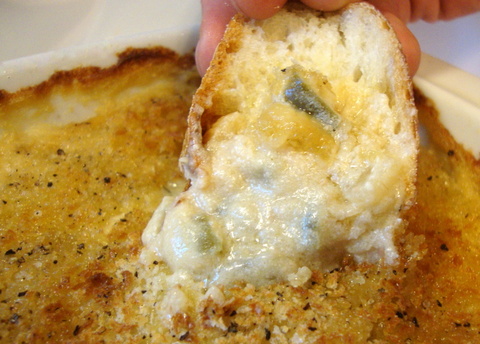
A zesty and cheesy Southwestern bean dip served hot with your favorite chips or bread for dipping.
Ingredients:
• 1 can (15 oz) or 2 cups cooked white beans (cannellini, navy or Great Northern)
• mild-flavor cooking oil
• 3 large jalapenos, seeded and diced
• 1 large Anaheim chili, seeded and diced or 1 can (4 oz) diced mild green chilies
• ½ medium onion, diced
• 3 cloves garlic, minced
• 1 and ¾ cup non-dairy milk (soymilk works best)
• ¼ cup tapioca flour (starch)
• 2 T nutritional yeast flakes
• 1 T mellow white miso paste
• 2 tsp fine sea salt or kosher salt
• 2 tsp lactic acid powder or 2 T fresh lemon juice
• 2 tsp apple cider vinegar
• ½ cup panko bread crumbs or plain, dry breadcrumbs
*Note: Use protective gloves when handling jalapeno peppers; or wash your hands thoroughly several times after handling.
Technique:
If using canned beans, rinse thoroughly until all traces of foam disappear. Drain well and set aside.
Preheat the oven to 375°F. Grease a small, shallow baking dish with cooking oil and set aside.
Add 2 tablespoons of cooking oil to a skillet and place over medium-low heat. Add the jalapeno, fresh Anaheim chili, onion and garlic with a pinch of salt and “sweat” the vegetables until softened (if using canned mild green chilies, set aside for later).
If using canned green chilies, add them at this time. Increase the heat to medium and sauté until any liquid has evaporated and the onions are translucent and lightly golden – do not brown. Transfer to a mixing bowl to cool.
In a small saucepan, whisk together the non-dairy milk, tapioca flour, nutritional yeast, miso, salt and acids. Whisk in 2 tablespoons of cooking oil and place over medium-low heat. Cook, stirring frequently, until the mixture is hot, cheesy, bubbly and smooth (the cheese sauce will be somewhat salty at this stage but will balance out when mixed with the bean purée and vegetables). Keep warm over low heat.
Place the white beans into a food processor and process into a paste. Alternately, mash the beans thoroughly with a potato masher or ricer. Transfer to the mixing bowl.
Add the cheese mixture to the mixing bowl and stir all ingredients thoroughly. Transfer to the greased baking dish, spread evenly and top with the panko crumbs. Season the topping with coarse ground black pepper and mist with cooking oil spray. The oil will help the crumbs brown in the oven.
Place on the middle rack of the oven and bake uncovered for 45 to 50 minutes or until browned and bubbly. To enhance browning if necessary, place under the broiler for about 1 minute.
Serve hot with warm tortilla chips, chunks of crusty bread or crackers. The dip will be saucy when very hot but will thicken substantially as it cools.
Print Recipe
Cheesy Jalapeno Popper Bean Dip
Votes: 2
Rating: 5
You:
Rate this recipe!
|
|
Votes: 2
Rating: 5
You:
Rate this recipe!
|
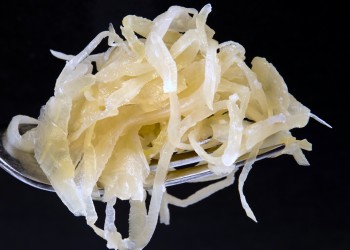
Sauerkraut is German for “sour cabbage,” but is originally a Chinese invention made with rice wine. Sauerkraut is made from finely cut cabbage that has been fermented by various lactic acid bacteria which propagate naturally during the fermentation process. It has a long shelf-life and a distinctively sour flavor, both of which result from the lactic acid that forms when the bacteria ferment the sugars in the cabbage.
Every chef has their own recipe for preparing sauerkraut and this is my personal formula and technique that works for me every time – with no undesirable mold blooms to skim from the surface of the brine during fermentation. Sauerkraut takes roughly 5 to 6 weeks from start to finish, so plan ahead and be patient – the results are worth waiting for.
Ingredients:
• 2 large heads green or red cabbage
• 3 T sea salt, kosher salt or pickling salt
• 3 cups filtered or spring water
• 1 T dried juniper berries (optional)
• 2 tsp caraway seeds (optional)
You will also need:
• 1 gallon wide-mouthed clear glass jar
• cheesecloth
• 2 one-quart zip-lock bags
• plastic wrap
Technique:
Before beginning, make sure the jar has been washed thoroughly with hot, soapy water and rinsed well; or run through the heated cycle in a dishwasher. Wash your hands thoroughly.
In a small saucepan, add 3 cups spring or filtered water and 1 teaspoon of the salt. Bring to a brief boil and remove from the heat to cool until lukewarm.
Remove any loose and damaged leaves from the heads of cabbage and either discard the leaves, save for preparing stock or compost. Split the heads of cabbage lengthwise (from the crown to the core). Cut a “V” shape to remove the tough core from each half.
Place a half head, cut side down, on a clean work surface and using a very sharp knife, begin to slice or “shave” the cabbage as thinly as possible to create very thin, long ribbons. Take your time slicing the cabbage, as very fine shreds will yield the best texture in the finished sauerkraut (personally, I use only the long, thin ribbons for the sauerkraut and save any pieces that are too large or too small for vegetable stock).
Place the shreds into the jar and sprinkle in 2 teaspoons of the salt. Repeat shredding the second half and place in the jar. Sprinkle again with 2 teaspoons salt. Using a potato masher or similar object, pack down the cabbage as firmly as possible. The salt will help draw out the juice from the cabbage to create the brine. If using the juniper berries and/or caraway seeds, sprinkle half over the cabbage.
Repeat with the second head of cabbage, adding 2 teaspoons of salt for each shredded half added to the jar. Pack down the cabbage again. If using the juniper berries and/or caraway seeds, sprinkle the remaining portion over the cabbage.
Fold a double layer of cheesecloth in half and cut to fit into the jar with some excess for tucking. Place on top of the cabbage shreds and using a dull table knife, tuck the cheesecloth snugly around the inner circumference of the jar. This will hold the shreds in place and keep them from floating upwards in the brine. Pour the cooled salted water over the cheesecloth.
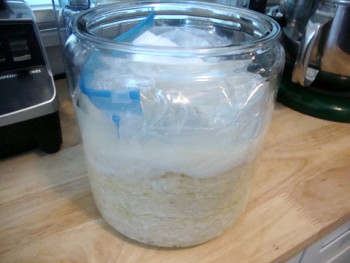
Fill a zip-lock bag about ⅔-full of water and seal. Tuck the bag into the second zip-lock bag and seal. The second bag will ensure that no leaks of water occur from the water-filled bag.
Place the water-filled bag into the jar on top of the cheesecloth. The weight of the bag will keep the mass of cabbage completely submerged in the brine during fermentation. If the cabbage is submerged completely, no undesirable mold blooms will occur. Seal the top of the jar with plastic wrap to prevent evaporation of the brine.
Place the jar in a cool place (a basement or cool pantry being ideal). A room temperature of 68 to 72 degrees is best for fermenting cabbage. Formation of gas bubbles after a few days indicates fermentation is taking place. Mark your calendar for 5 to 6 weeks.
Once a week, check the jar. The formation of gas bubbles will sometimes cause the packed shreds to rise in the jar, which can potentially expose the surface to air, thus encouraging undesirable mold blooms. Simply remove the plastic film and re-tuck and push the cheesecloth down around the inner circumference with the edge of a spoon. There’s no need to remove the bag of water; simply work around it (but be careful not to puncture the bag!). Re-seal the top of the jar with plastic wrap.
When fermentation is complete, pack individual mason jars with the sauerkraut and add enough brine to keep the shreds covered with the liquid, while leaving ½-inch of headspace in the jar. Fully fermented sauerkraut can be kept tightly covered in the refrigerator for a few months. The sauerkraut can be eaten raw, which promotes a healthy intestinal flora; or it can be cooked and used in your favorite recipe.
Print Recipe
Raw Sauerkraut
Votes: 0
Rating: 0
You:
Rate this recipe!
|
|
Votes: 0
Rating: 0
You:
Rate this recipe!
|
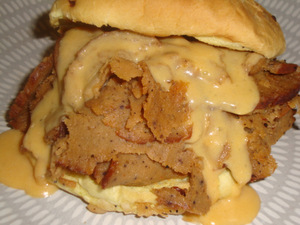
This instant mix is a convenient timesaver for creating a rich and tangy cheddar cheese sauce for topping hot sandwiches or pouring over potatoes, pasta, rice or cooked vegetables. This recipe yields 2 cups of dry mix which will make 8 cups of cheddar cheese sauce.
Ingredients:
• 1 cup nutritional yeast flakes
• 1 cup tapioca flour
• 3 T onion powder
• 3 T tomato powder
• 4 tsp fine sea salt or kosher salt
• 2 tsp lactic acid powder (order from ModernistPantry.com)
• 2 tsp dry ground mustard
• 1 tsp garlic powder
Technique:
Process the ingredients in a DRY blender or food processor until finely powdered. Store the seasoning blend in an airtight container at room temperature in a cool, dry place for up to 6 months.
To make 1 cup of cheese sauce, whisk together in a small saucepan until smooth:
• ¼ cup dry mix
• ¾ cup plus 2 tablespoons plain unsweetened non-dairy milk
(soymilk is recommended)
• 2 tablespoons olive oil
Place the saucepan over medium-low heat and cook the mixture, stirring slowly and continually with a silicone/rubber spatula until the mixture becomes thickened, smooth and glossy. Taste and add salt as desired. Reduce the heat to low to keep warm until ready to serve; stir occasionally.
Print Recipe
Instant Cheddar Cheese Sauce Mix
Votes: 24
Rating: 3.54
You:
Rate this recipe!
|
|
Votes: 24
Rating: 3.54
You:
Rate this recipe!
|
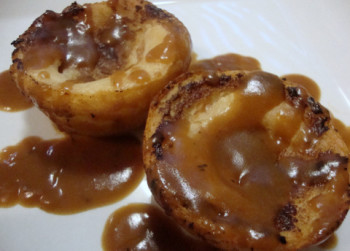
Yorkshire Pudding is an English dish traditionally made from a batter consisting of eggs, flour, and milk and then baked in hot pan drippings. It’s not a pudding in the American sense of the word but rather a cross between a popover and a soufflé. The dish is usually served with roast meat and gravy and is a staple of British cuisine.
Creating a vegan version without eggs poses a fundamental problem, since the eggs are necessary to inflate the batter as the pudding cooks. However, with a few adjustments and substitutions a very satisfying, albeit less inflated version can be made. Be sure to read though the directions first and then follow them carefully for success. Serve the “Yorkies” with sliced roast seitan and plenty of savory gravy.
Ingredients:
• 1 cup unbleached all-purpose flour
• ½ tsp fine sea salt or kosher salt
• 2 T olive oil
• 1 T vegan butter or margarine, melted
• 1 tsp vegan Worcestershire sauce
• ¼ cup very warm water
• 1 T Ener-G™ egg replacer powder (or similar)
• ¼ tsp baking powder
• 1 cup plain unsweetened soymilk, room temperature
Technique:
Preheat the oven to 425°F.
Sift together the flour and salt into a mixing bowl.
In a small dish, mix together the melted butter or margarine with the Worcestershire sauce and 1 tablespoon olive oil. Spoon a little over one teaspoon into the bottoms of a 6-cup muffin tin (in other words, divide evenly).
In a small bowl, whisk together the very warm water, egg replacer powder and baking powder until frothy.
Place the muffin tin in the oven and set a timer for 3 minutes to heat the “pan drippings”.
Meanwhile, add the soymilk, egg replacer mixture and the remaining tablespoon of olive oil to the flour and whisk vigorously until a smooth batter is achieved.
After 3 minutes, remove the muffin tin from the oven and immediately pour the batter, dividing evenly in each cup (about ⅓ of the way full). Place in the oven on a middle rack and set a timer for 35 minutes. Keep in mind that the puddings will have inflated only slightly and not in a dramatic fashion as their traditional egg-laden counterparts.
Remove the muffin tin from the oven and let cool for about 5 minutes. Serve hot.
Print Recipe
Mini Yorkshire Puddings
Votes: 0
Rating: 0
You:
Rate this recipe!
|
|
Votes: 0
Rating: 0
You:
Rate this recipe!
|





